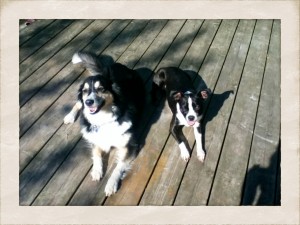My dog, Piper, is awesome. The reason she’s awesome: shortly after getting her from the local SPCA, I spent a lot of time training her. I have continued training her over the past 9 years. The more time I have spent training her, the more I have noticed parallels between dog training and employee training. Here are a few principles that work for both.
- Positive reinforcement works. For Piper, I used a clicker during training, so that she knew exactly what she did that was being rewarded. I would click immediately when she performed the action I had told her to, and then give her a treat. She had no question about why she was being rewarded, because the click linked her action with a treat. For people, it’s not as simple as a clicker and a treat (I wish!), but giving specific, timely recognition is one of the basic keys to effective leadership. For people and dogs, what is recognized will be repeated.
- Corrective feedback must be timely, too. When dogs do something “bad”, like get into the garbage or eat your favourite slipper, you have to catch them in the moment to change the behaviour. Dog owners, I know what you’re thinking… “My dog knows she’s done something bad when I get home and there’s trash on the floor”… and you’re right, partly. The dog knows that when there’s trash on the floor, you get mad. She doesn’t know that the act of chewing the trash is what’s bad, so this behaviour will likely continue until you catch her in the act. For people, this is like waiting until an annual performance review to tell your employee what they’ve done wrong all year. Leaders must coach in the moment and correct mistakes or inappropriate behaviour when it happens.
- Give them a chance to do good work. For Piper, once I give her a command, I give her a chance to try it before I show her what I want. An example is the “come” command. If you pull on the leash while you are telling your dog to come, they’re learning that a tug on the leash means “come”. You have to give them a chance to practice the behaviour before stepping in to correct. With people, this is akin to micro-managing. If you’re constantly telling people exactly what to do and how, their learning curve will be slower, and they will actually start to lose confidence and motivation. Give people a chance to figure things out – they may not complete things exactly the way you expected, and they may make mistakes along the path to learning, but they will learn.
- Bite-sized chunks are best. I don’t mean bite-sized kibble, but breaking tasks down works for people and dogs. When I train Piper, we only practice each command 5-8 times before moving on to a different trick or lesson. For her, this keeps he interested. Border collies can get bored if their minds aren’t engaged. It also allows them to learn faster when learning a long trick. For example, if you want to teach your dog to get you a beer from the refrigerator, you need to break this trick into chunks. I started with teaching Piper how to close the fridge. For employee training, when people are first learning a major action or working on a large project, it can be overwhelming. Break it into chunks, give breaks so that they can absorb the information, practice each task, and they will actually learn faster.
- Support continuous learning. This is partly a border collie thing, but I think it’s a great idea to continue to train and practice with your dog. For Piper, the border collie in her needs to keep her brain active. Border colllies are at their best when they have a job to do. Living in the city, she’s not herding cattle, so her job is to learn and to practice the things I teach her. For leaders, providing opportunities to learn and grow is one of the key engagement factors for people. People can also get bored if they aren’t able to continue to grow. Provide continuous opportunities for development.
- Finally, have fun! Piper and I have so much fun learning together. She feeds off of my positive energy and vice versa. When it stops being fun, she stops learning. For people, having fun at work is essential in my book. People are more engaged and more productive if they are having fun. Laugh together, celebrate success, and encourage cameraderie and having fun together as a team.
I continue to learn from Piper every day. What have you learned from your pet?


Hi Pam, Thanks for sharing your post with me. I love your correlation between your dog and leadership. Marie Peyton wrote a post about her dog Oliver which shared lots of fun things too. I think positive reinforcement works for so many things and can never get old. Regardless of who you are or your situation, a heartfelt compliment or just someone saying that you did a good job on something is so appreciated. Love it! Peggy
Hi Peggy, Thanks for reading! Your upcoming #mybookclub topic reminded me of the post and I thought you might enjoy it. I'll make sure I check out Marie's post too. And I totally agree about positive reinforcement. It makes a huge difference for people and performance. Thanks, Pam
We deitlfieny need more smart people like you around.
i got my first dog - a toy poodle, and was thinking exactly the same from my training experience. I am a HR practitioner too.
Thanks for commenting William! I tell you, every time I spend time with my dog, I learn more about people! Glad to hear other people experience the same things.